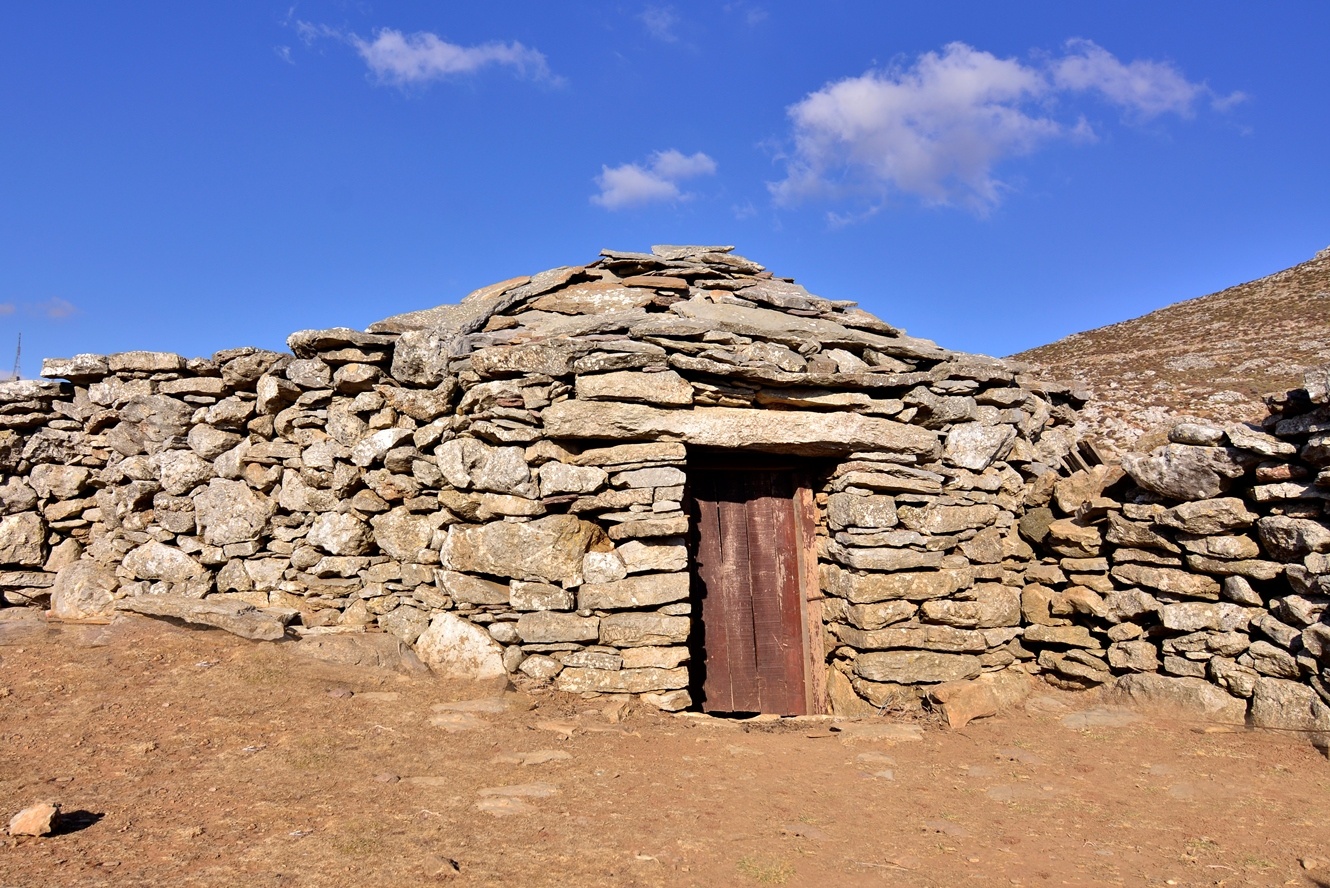
For those not familiar with the term mitato, the region of the Asterousia Mountain Range offers an excellent opportunity to discover its meaning first-hand.
Alongside the region’s country highways and unpaved rural roads, which seem to suddenly appear around every corner and lead to mesmerising natural locations and villages, small stone-built structures can be seen tucked away between rocks or perched atop minor peaks and ridges along the length of the mountain range.
They are the famed mitata: huts that provided shelter to shepherds and their flocks and were also used as pastoral cheese-dairies. Here, in the Asterousia Mountains, they don’t always exhibit the typical domed shape that can be seen across most of the island; there are square ones and rectangular ones, as well as others with abstract shapes that follow the land’s natural contours. Wherever there were pastures, there was usually a mitato. They were often built at sites with natural caves, and, if the length of the cave allowed it, its furthest recess was then used as a natural refrigerator to let cheeses ripen. Outside the mitato there was a rudimentary yard and, next to it, the fold, which confined animals during milking.
Despite not having been studied as extensively as those in Anogeia and the broader region of Mylopotamos, the mitata on the Asterousia Mountains, with their impressive range of shapes and their distinct character and charm, merit particular attention. Particularly in the district of Achentrias, which is the liveliest livestock village in the eastern Asterousia mountains, with any mitata still functioning. Cheeses fermented here are amongst the most renowned of this mountain region.
Do not hesitate to approach the hospitable shepherds, particularly if you happen upon them on the mountain slopes or at their mitata.
Yet, beware of sheepdogs that are usually around working mitata.
Necessity
Mitata are usually found in clusters of family clans, at considerable distance from each other. Often, they form complexes affording additional auxiliary spaces.
In this particular natural environment, with limited material and financial resources, inhabitants naturally came to this building method. This is clear, considering that mitata are built using limestone sourced from the actual building site. Another advantage of this type of structure is that it can withstand storms and snow and its upkeep is simple, since the building material is readily available. Whilst no one can conclusively determine the origins and spread of such structures on Crete, be they vaulted tombs or mitata, it stands to reason that they are historically native to the land, for the reasons discussed above.
Origins
The similarities, in both morphology and typology, between mitata and Minoan tholos (dome) tombs (e.g. the tomb at Furni) leave little room for doubt as to their origins.
Etymologically, the word for these primitive dry-stone structures with the characteristic beehive (or corbelled) domes comes from the Latin term metatum, meaning ‘military lodging’. Throughout the Byzantine period the term referred to temporary shelters and it is still used on Crete to this day with the very same meaning. Whilst it is rather difficult to date mitata, their construction—or re-construction—date is estimated based on the engravings on the lintel stones, jambs, and other parts of their masonry. In all likelihood, mitata existed even earlier, but their building materials were recycled to construct new ones on the same locations.
Round, domed structures proliferated on Crete in early antiquity. The theory that these were introduced by or the result of cultural influence of peoples Crete traded with does not seem to stand. This is because during the same period (late-3rd and early-2nd millennium B.C.) that the beehive/corbelled-domed structure appears in various cultures around the Mediterranean, its already sophisticated construction style on Crete attests to pre-existing technical know-how gained through practical experience.
After all, whilst other civilizations were using these primitive domed structures as residences, the Minoans, having made huge qualitative advances in the conception of their residences, used the earlier structures as tombs and built palaces and mansions to live in.
Architecture
Domed mitata are dry-stone structures with a dome and are shaped like truncated cones.
The domes are constructed using the corbelling method, so that every layer of stone projects slightly more towards the centre of the dome than the one below it. At their top, their crown is a short, slightly protruding cone that barely juts out from the main structure.
Mitata either stand alone, with a small yard within which necessary tasks are carried out, or constitute part of a complex that includes another mitato, known as the kleidospito (‘keyhouse’) or tyrokeli (‘cheese cell’), used for storing and maturing cheeses. Next to every mitato there is a mantra, or fold, for keeping sheep. Other auxiliary spaces include a type of small cellar known as koumos and an outdoors sitting area that is also used for dining.
Within the mitato proper, there is always a hearth, which is normally centrally situated, and some benches for sitting and sleeping on. The top of the dome features a small hole, the aniforas (lit. acclivity), which measures approximately 20–30 cm across and serves to let the light in and let the smoke out.
As regards the entrance, it is identical to those of Minoan vaulted tombs—made using monoliths. Mitata are usually built on solid, flat ground in rocky areas, in order to facilitate the quarrying and transportation of raw materials. Construction begins after the site has been levelled and cleared.



